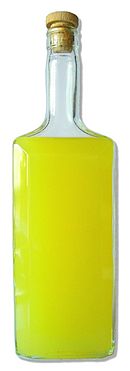Limoncello facts for kids

Homemade limoncello
|
|
| Type | Alcoholic beverage |
|---|---|
| Main ingredients | Water, lemon zest, rectified spirit, sugar |
Limoncello is a popular Italian lemon-flavored drink. It is a type of liqueur made from lemons. It comes mainly from Southern Italy, especially around the Gulf of Naples, the Amalfi Coast, and Sicily. Limoncello is the second most popular liqueur in Italy. People usually drink it cold after dinner. Many families also make it at home using their own recipes.
Limoncello gets its flavor from the zest (the colorful outer part) of lemons. It often looks a bit cloudy. This cloudy look comes from tiny drops of essential oil from the lemons floating in the drink.
Contents
The Story of Limoncello
No one is completely sure when or where Limoncello was first made. It's a bit of a mystery!
Some people say it was created in the early 1900s. They believe a grandmother named Maria Antonia Farace, who lived in a small guesthouse, made it first. Other stories suggest it was invented about 100 years ago in Sicily. Some also say it started on the Amalfi Coast. Many towns and islands there claim to be its birthplace.
One journalist, Kristen Tillotson, wrote that it might have been invented around 1900 by a person who took care of citrus groves. Or, it could have been made much earlier by monks or fishermen.
How Limoncello is Made
Limoncello is mostly made in Southern Italy. This includes areas like the Gulf of Naples, the Amalfi Coast, and Sicily.
Traditionally, it's made from the zest of special lemons. These are often called Femminello St. Teresa lemons, or Sorrento lemons. First, the lemon zest (the yellow part, without the white pith) is soaked in pure alcohol. This process helps release the lemon's oils.
Next, the yellow liquid is mixed with a simple sugar syrup. The amount of sugar and water, and the temperature, can change how clear, thick, and flavorful the drink is. The cloudy look of Limoncello comes from tiny drops of lemon oil. These oils mix with the sugar syrup, making it look opaque.
In 2003, about 15 million liters of Limoncello were made for sale.
Popularity of Limoncello
Limoncello is very popular in Italy. It is the second most popular liqueur there, after Campari.
Serving Limoncello
People usually serve Limoncello very cold after dinner. It is a traditional "digestivo," which means it's thought to help with digestion. Along the Sorrentine Peninsula and the Amalfi Coast, it's often served in small ceramic glasses. These glasses are also chilled to keep the drink extra cold. This tradition is now common in other parts of Italy too.
Different Kinds of Limoncello
There are many variations of Limoncello. They use different fruits or ingredients for flavor:
- Arancello is made with oranges.
- Agrumello uses a mix of different citrus fruits.
- Pistachiocello is flavored with pistachio nuts.
- Meloncello tastes like cantaloupe.
- Fragoncello is made with strawberry.
There is also a version called crema di limoncello. This one uses milk instead of simple syrup. It usually has less alcohol than regular Limoncello.
Images for kids
See also
 In Spanish: Limoncello para niños
In Spanish: Limoncello para niños
- Villa Massa Limoncello – a brand of limoncello made in Italy


